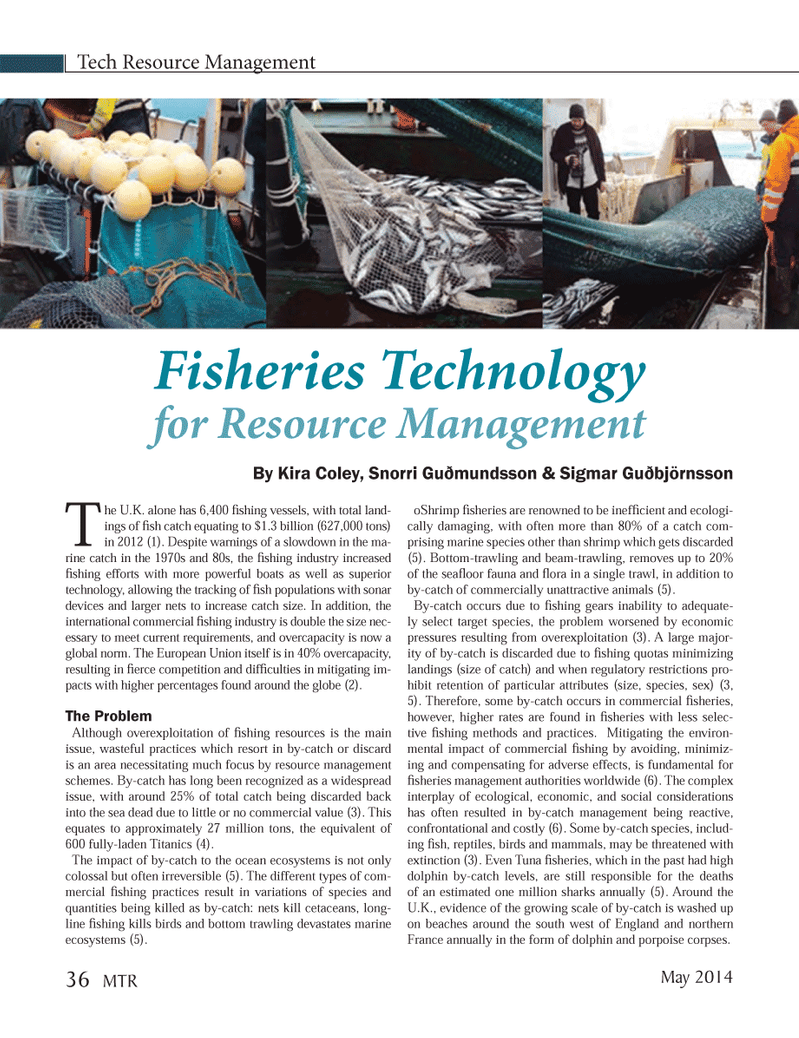
Page 36: of Marine Technology Magazine (May 2014)
AUV Operations
Read this page in Pdf, Flash or Html5 edition of May 2014 Marine Technology Magazine
Tech Resource Management The U.K. alone has 6,400 Þ shing vessels, with total land- ings of Þ sh catch equating to $1.3 billion (627,000 tons) in 2012 (1). Despite warnings of a slowdown in the ma- rine catch in the 1970s and 80s, the Þ shing industry increased Þ shing efforts with more powerful boats as well as superior technology, allowing the tracking of Þ sh populations with sonar devices and larger nets to increase catch size. In addition, the international commercial Þ shing industry is double the size nec- essary to meet current requirements, and overcapacity is now a global norm. The European Union itself is in 40% overcapacity, resulting in Þ erce competition and difÞ culties in mitigating im- pacts with higher percentages found around the globe (2). The Problem Although overexploitation of Þ shing resources is the main issue, wasteful practices which resort in by-catch or discard is an area necessitating much focus by resource management schemes. By-catch has long been recognized as a widespread issue, with around 25% of total catch being discarded back into the sea dead due to little or no commercial value (3). This equates to approximately 27 million tons, the equivalent of 600 fully-laden Titanics (4). The impact of by-catch to the ocean ecosystems is not only colossal but often irreversible (5). The different types of com- mercial Þ shing practices result in variations of species and quantities being killed as by-catch: nets kill cetaceans, long-line Þ shing kills birds and bottom trawling devastates marine ecosystems (5). oShrimp Þ sheries are renowned to be inefÞ cient and ecologi- cally damaging, with often more than 80% of a catch com-prising marine species other than shrimp which gets discarded (5). Bottom-trawling and beam-trawling, removes up to 20% of the seaß oor fauna and ß ora in a single trawl, in addition to by-catch of commercially unattractive animals (5). By-catch occurs due to Þ shing gears inability to adequate- ly select target species, the problem worsened by economic pressures resulting from overexploitation (3). A large major- ity of by-catch is discarded due to Þ shing quotas minimizing landings (size of catch) and when regulatory restrictions pro- hibit retention of particular attributes (size, species, sex) (3, 5). Therefore, some by-catch occurs in commercial Þ sheries, however, higher rates are found in Þ sheries with less selec- tive Þ shing methods and practices. Mitigating the environ- mental impact of commercial Þ shing by avoiding, minimiz- ing and compensating for adverse effects, is fundamental for Þ sheries management authorities worldwide (6). The complex interplay of ecological, economic, and social considerations has often resulted in by-catch management being reactive, confrontational and costly (6). Some by-catch species, includ-ing Þ sh, reptiles, birds and mammals, may be threatened with extinction (3). Even Tuna Þ sheries, which in the past had high dolphin by-catch levels, are still responsible for the deaths of an estimated one million sharks annually (5). Around the U.K., evidence of the growing scale of by-catch is washed up on beaches around the south west of England and northern France annually in the form of dolphin and porpoise corpses. Fisheries Technology for Resource Management By Kira Coley, Snorri Guðmundsson & Sigmar Guðbjörnsson May 201436 MTRMTR #4 (34-49).indd 36MTR #4 (34-49).indd 365/12/2014 4:15:27 PM5/12/2014 4:15:27 PM

 35
35

 37
37
